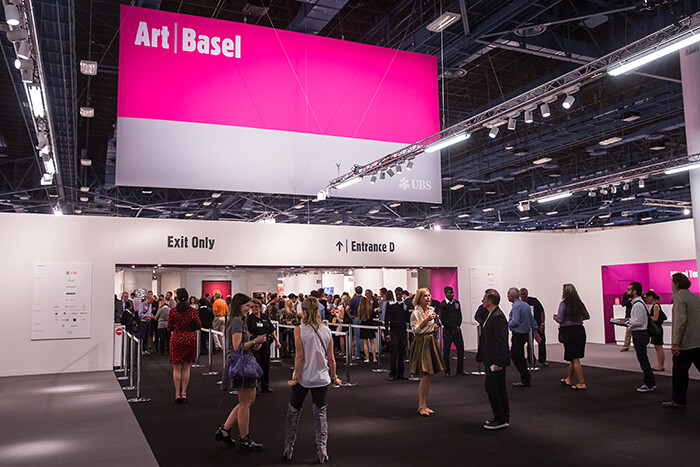The site of the apocalypse is not spatial, but temporal, and right now it is in Miami. Every December, clouds of glowering collectors stumble onto and through each other, fingering abstract paintings and driving rented Lambos. Perversely, beyond the work of certain depraved dealers, conniving collectors, and the substandard artists that many of them choose to support (or ruin, depending on your point of view), there is also an abundance of good things to be found in this year’s Art Basel Miami Beach, especially if you strain your eyes away from the remarkably dreadful Christian Rosas, Israel Lunds, Ned Venas, et al.
My first interesting encounter was with New York gallery James Fuentes’s small but charming booth, which contains a large sculpture titled The Boat Book (2014) by Alison Knowles. It is an oversized wood-and-found-object structure loosely mimicking the form of a seven-foot-tall book (with a spine and pages), and displays an assortment of various nautical objects and images. Knowles has long been under-recognized in the artworld—her 1960s food-making and eating performances far predated those of Rikrit Tiravanija, yet she is infrequently mentioned in the same breath. Fittingly, it is not surprising, though slightly disappointing, to see Knowles’s work outside of a more established venue, but heartening nonetheless to see a smaller, younger gallery take a chance on it.
Another daringly underrated artist with a solo booth is Jack Early at New York’s Fergus McCaffrey. Showing large, colorful oil paintings of buff men, bean-bag sculptures of grumpy women, and a strangely American phonograph sculpture titled Jack Early’s Lifestory in Just Under 20 Minutes (2014), Early’s star is gradually recuperating, albeit at a snail’s pace compared to his former partner-in-crime Rob Pruitt. The work feels patriotic—at around 20 minutes, it’s the average length of an American reality TV show episode.
Of the younger artists who seem to be doing something new, Ajay Kurian at New York’s 47 Canal is showing curious trash-can sculptures/elegies whose content is poetic and whose form is brusquely clean. One of them, Without polish (Care) (2014), has a sad frog sitting on it—a strangely heartbreaking moment. Also notable are Van Hanos’s sometimes gloomy and always unsettling figurative oil paintings at Berlin’s Tanya Leighton Gallery. Hanos is making challenging work that exists outside of the stagnant waters of process-based abstraction, and for that he should be watched carefully.
One of the blue-chip mainstays doing nice things is London’s Sadie Coles HQ, showing, among other works, Urs Fischer’s large sculptural installation (Small Rain, 2014). Fischer’s piece is a multitude of hanging, windswept, six-inch ceramic raindrops and clay couch-like shapes, deteriorating as if they were being pummeled by the rain. Playful and dark, the work exemplifies the type of daring that Fischer is known for. Another historied gallery, Galerie Buchholz (in Cologne and Berlin) is showing a collection of wonderful work by Richard Hawkins, Wolfgang Tillmans, Thomas Houseago, and Nairy Baghramian, though none of these artists’ work seems especially new—just more of the same stuff for which we already appreciate them.
Mexico City’s kurimanzutto has a nice grouping of work by Allora & Calzadilla, which seems to have the fair’s most thematically appropriate work: palm trees standing tall on large, printed canvases. They look good, and feel gritty, and their pairing with strange, industrial-looking figure-eight tubes seems right. Greene Naftali, New York, gets points, too, for having the sole representation of recent Hugo Boss Prize winner Paul Chan, whose blob-like book stand holding his catalogue raisonné of book paintings, the New New Testament (2014), was in their booth. Also at Greene Naftali are several works by Lutz Bacher, straddling the line between fabrication and insanity. Another standout is Sam Pulitzer’s bizarre sculptures at Real Fine Arts, New York. Trading between high production value and apparent refuse, Pulitzer’s works seem to be made by maddened machines; the nice, expensive-looking objects are good policy for an art fair. Working in a similar vein is Sean Raspet, whose wall of mysterious vats of fluid at Berlin’s Société ties with Pulitzer for weirdest dogmatic lo-fi sci-fi sculpture at the fair.
Given the artist’s lack of representation in galleries and museums, it was quite a surprise to bump into a manifold of works by the late Italian sculptor par excellence Fausto Melotti (1901–1986) at Galería Elvira González, Madrid. The plasters, bronzes, and various other metals and paints have both surreal and arte povera leanings. Melotti’s fabulous inventions were so dreamily produced that they have absolute kinship with those of very few artists; the works of Enrico David, however, on view at New York’s Michael Werner, are an exception. This is especially true of David’s sculpture Metamorophice (2014), which acts like a surreal diorama for a terrifyingly unwinnable chessboard. One of the few galleries that retains a boutique feel, as opposed to the department-store vibe of the other blue-chips, Michael Werner has an impressive lineup, including a smart inkjet and airbrushed canvas by Michael Williams, several sculptures by James Lee Byars, and some good, old-fashioned paintings by Per Kirkeby, A.R. Penck, and Aaron Curry.
The phenomenon of Art Basel Miami Beach serves the art market well, offering fair-goers the perfect balance between attention and distraction. Luring its viewers into a numbed parade of “high culture,” it keeps reminders of political realities both inside and outside the art world at bay. Miami is simultaneously the site of the apocalypse and its prevarication.














